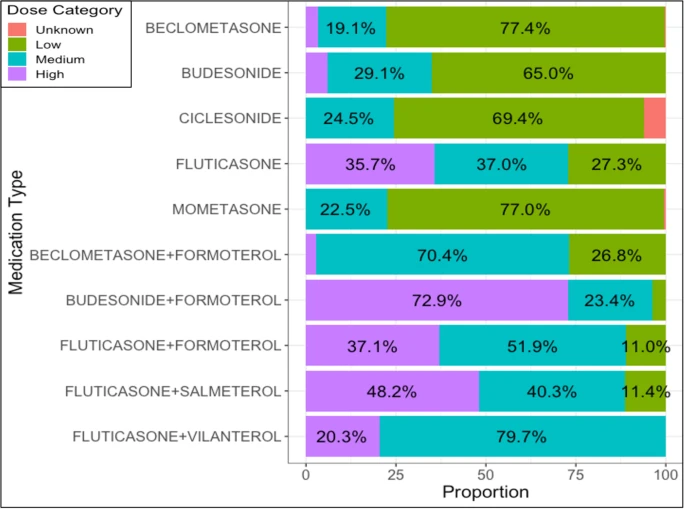Background:
Asthma severity is typically assessed through a retrospective assessment of the treatment required to control symptoms and to prevent exacerbations. The joint British Thoracic Society and Scottish Intercollegiate Guidelines Network (BTS/SIGN) guidelines encourage a stepwise approach to pharmacotherapy, and as such, current treatment step can be considered as a severity categorisation proxy.
Briefly, the steps for adults can be summarised as: no controller therapy (Step 0), low-strength Inhaled Corticosteroids (ICS; Step 1), ICS plus Long-Acting Beta-2 Agonist (LABA; Step 2), medium-dose ICS + LABA (Step 3), and finally either an increase in strength or additional therapies (Step 4). This study aimed to investigate how BTS/SIGN Steps can be estimated from across a large cohort using electronic prescription records, and to describe the incidence of each BTS/SIGN Step in a general population.
Methods:
There were 41,433,707 prescriptions, for 671,304 individuals, in the Asthma Learning Health System Scottish cohort, between 1/2009 and 3/2017. Days on which an individual had a prescription for at least one asthma controller (preventer) medication were labelled prescription events. A rule-based algorithm was developed for extracting the strength and volume of medication instructed to be taken daily from free-text data fields. Asthma treatment regimens were categorised by the combination of medications prescribed in the 120 days preceding any prescription event and categorised into BTS/SIGN treatment steps.
Results:
Almost 4.5 million ALHS prescriptions were for asthma controllers. 26% of prescription events had no inhaled corticosteroid prescriptions in the preceding 120 days (Step 0), 16% were assigned to BTS/SIGN Step 1, 7% to Step 2, 21% to Step 3, and 30% to Step 4. The median days spent on a treatment step before a step-down in treatment was 297 days, whereas a step-up only took a median of 134 days.Conclusion
We developed a reproducible methodology enabling researchers to estimate BTS/SIGN asthma treatment steps in population health studies, providing valuable insights into population and patient-specific trajectories, towards improving the management of asthma.


No comments:
Post a Comment